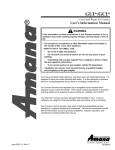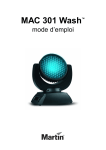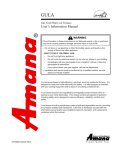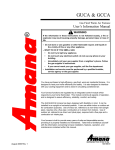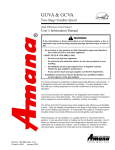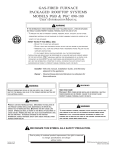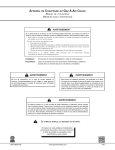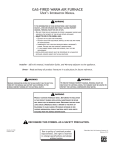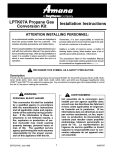Download Amana VR8205 Installation guide
Transcript
PACKAGE GAS-ELECTRIC USER’S INFORMATION MANUAL DESIGN CE RT I F I E D CE RT IF IE D ® ® WARNING IF THE INFORMATION IN THESE INSTRUCTIONS IS NOT FOLLOWED EXACTLY, A FIRE OR EXPLOSION MAY RESULT CAUSING PROPERTY DAMAGE, PERSONAL INJURY OR LOSS OF LIFE. – DO NOT STORE OR USE GASOLINE OR OTHER FLAMMABLE VAPORS AND LIQUIDS IN THE VICINITY OF THIS OR ANY OTHER APPLIANCE. – WHAT TO DO IF YOU SMELL GAS: • DO NOT TRY TO LIGHT ANY APPLIANCE. • DO NOT TOUCH ANY ELECTRICAL SWITCH; DO NOT USE ANY PHONE IN YOUR BUILDING. • IMMEDIATELY CALL YOUR GAS SUPPLIER FROM A NEIGHBOR’S PHONE. FOLLOW THE GAS SUPPLIER’S INSTRUCTIONS. • IF YOU CANNOT REACH YOUR GAS SUPPLIER, CALL THE FIRE DEPARTMENT. – INSTALLATION AND SERVICE MUST BE PERFORMED BY A QUALIFIED INSTALLER, SERVICE AGENCY OR THE GAS SUPPLIER. Installer - Affix this manual, Installation Guide, and Warranty adjacent to the appliance. Owner - Read and keep all product literature in a safe place for future reference. WARNING WARNING TO AVOID PROPERTY DAMAGE, PERSONAL INJURY OR DEATH, DO NOT USE SHOULD OVERHEATING OCCUR, OR THE GAS SUPPLY FAIL TO SHUT OFF, SHUT OFF THE MANUAL GAS VALVE TO THE FURNACE BEFORE SHUTTING OFF THE ELECTRICAL SUPPLY. THIS FURNACE IF ANY PART OF THE FURNACE HAS BEEN UNDER WATER. IMMEDIATELY CALL A QUALIFIED SERVICE TECHNICIAN TO INSPECT THE FURNACE AND TO REPLACE ANY PART OF THE CONTROL SYSTEM AND ANY GAS CONTROL HAVING BEEN UNDER WATER. WARNING PRODUCT CONTAINS FIBERGLASS WOOL. DISTURBING THE INSULATION IN THIS PRODUCT DURING INSTALLATION, MAINTENANCE, OR REPAIR WILL EXPOSE YOU TO FIBERGLASS WOOL. BREATHING THIS MAY CAUSE LUNG STATE OF CALIFORNIA TO CANCER. (FIBERGLASS WOOL IS KNOWN TO THE CAUSE CANCER.) FIBERGLASS WOOL MAY ALSO CAUSE RESPIRATORY, SKIN, TO REDUCE EXPOSURE OR FOR FURTHER AND EYE IRRITATION. INFORMATION, CONSULT MATERIAL SAFETY DATA SHEETS AVAILABLE FROM ADDRESS SHOWN BELOW OR CONTACT YOUR SUPERVISOR. RECOGNIZE THIS SYMBOL AS A SAFETY PRECAUTION. *NOTE: Please contact your distributor or our website for the applicable product data book referred to in this manual. Part No. 10500226 Printed in U.S.A. ® is a trademark of Maytag Corporation and is used under license to Goodman Company, L.P. All rights reserved. 2002-2004 Goodman Company, L.P. Effective: May 2004 SIGNAL WORDS Dear Homeowner, please recognize the following safety information. This information will alert you to the potential for personal injury. Gutters or deflectors must be installed on the roof to prevent water from shedding on the unit. 1. An area must be available to reach the unit in a clear and unobstructed path. WARNING - Indicate hazards or unsafe practices which COULD 2. The unit area and the vicinity of any other gas appliances must be kept clear and free of combustible materials, gasoline, and result in severe personal injury or death. other flammable vapors and liquids. Also, do not store or use flammable items such as paint, varnish, or lacquer in the area. CAUTION - Indicate hazards or unsafe practices which COULD 3. The combustion air supply must not be contaminated by prodresult in minor personal injury or product or property damage. ucts containing chlorine or fluorine, as they could corrode the heat exchanger. If you need further information on this subject, WARNING contact your installing dealer or another qualified servicer. THIS PRODUCT CONTAINS OR PRODUCES A CHEMICAL OR CHEMICALS WHICH MAY CAUSE SERIOUS ILLNESS OR DEATH AND WHICH ARE KNOWN TO THE STATE OF CALIFORNIA TO CAUSE CANCER, BIRTH DEFECTS OR OTHER REPRODUCTIVE HARM. 4. Familiarize yourself with the controls that turn off the gas and electrical power to the unit. If the unit is to be shut down at the end of the heating season, turn off both the gas and electrical power. For safety, always turn them off before performing service or maintenance on the unit. 5. Establish a regular service and maintenance schedule to ensure efficient and safe operation of the unit. WARNING TO AVOID POSSIBLE EQUIPMENT DAMAGE, PERSONAL INJURY, FIRE OR DEATH, THE FOLLOWING INSTRUCTIONS MUST BE OBSERVED REGARDING UNIT LOCATION, AIR REQUIREMENTS AND OPERATING PROCEDURES. 6. The unit must be placed where no runoff water from higher ground can collect in the unit. UNIT INSTALLATION Examine the unit installation to determine the following: 1. The vent connector is in place and is physically sound without holes or excessive corrosion. WARNING HEATING UNIT SHOULD NOT BE UTILIZED WITHOUT REASONABLE, ROUTINE, INSPECTION, MAINTENANCE AND SUPERVISION. IF THE BUILIDNG IN WHICH ANY SUCH DEVICE IS LOCATED WILL BE VACANT, CARE SHOULD BE TAKEN THAT 2. The physical support of the unit is sound without sagging, cracks, or gaps around the base so as to provide a seal between the support and the base. SUCH DEVICE IS ROUTINELY INSPECTED, MAINTAINED AND MONITORED. IN THE 3. There are no obvious signs of deterioration of the unit. EVENT THAT THE BUILDING MAYBE EXPOSED TO FREEZING TEMPERATURES 4. The burner flames are stable, soft and blue, (dust may cause orange tips but must not be yellow). The flames should extend directly outward from the burner without curling, floating, or lifting off. To examine, turn on the electrical power and gas. Set the room temperature to the maximum setting. AND WILL BE VACANT, ALL WATER-BEARING PIPES SHOULD BE DRAINED, THE BUILDING SHOULD BE PROPERLY WINTERIZED, AND THE WATER SOURCE CLOSED. IN THE EVENT THAT THE BUILDING MAY BE EXPOSED TO FREEZING TEMPERATURES AND WILL BE VACANT, ANY HYDRONIC COIL UNITS SHOULD BE DRAINED AS WELL AND, IN SUCH CASE, ALTERNATIVE HEAT SOURCES SHOULD BE UTILIZED. IMPORTANT NOTE TO THE OWNER It is important that you fill out the owner’s registration card and mail it today. This will assist us in contacting you should any service or warranty information change in the future. When filling in the registration card, be sure to include the Model, Manufacturing and Serial Numbers, plus the installation date. If the registration card cannot be located, please call 1-877-254-4729 to register the furnace. Your warranty certificate is also supplied with the unit. Read the warranty carefully and note what is covered. Keep the warranty certificate in a safe place, so you can find it, if necessary. Before using this manual, check the serial plate for proper model identification. The installation and servicing of this equipment must be performed by qualified, experienced technicians only. Check the burner flames for: 1. Good adjustment 2. Stable, soft and blue 3. Not curling, floating, or lifting off. Burner NOTE: If a strong wind is blowing, it may not be possible to perform the flame inspection. GENERAL INFORMATION UNIT LOCATION This unit is approved only for an outdoor installation. The diagram in the Product Data Book applicable to your model* illustrates the required clearances to the unit. It is important that safety measures are taken in the surrounding area of the unit. *NOTE: Please contact your distributor or our website for the applicable product data book referred to in this manual. 2 WARNING WARNING PERSONAL INJURY OR DEATH FROM ASPHYXIATION CAN RESULT FROM EXPOSURE TO CARBON MONOXIDE. CARBON MONOXIDE OR “CO” IS A TO AVOID PERSONAL INJURY OR FIRE, MINIMUM CLEARANCES TO COMBUSTIBLE SURFACES MUST BE FOLLOWED. COLORLESS AND ODORLESS GAS PRODUCED WHEN FUEL IS NOT BURNED AIR REQUIREMENTS COMPLETELY OR WHEN THE FLAME DOES NOT RECEIVE SUFFICIENT OXYGEN. BE AWARE OF THESE AIR STARVATION SIGNALS WHICH INDICATE CONDITIONS THAT MAY RESULT IN CARBON MONOXIDE OR THAT CARBON MONOXIDE MAY WARNING BE PRESENT: 1. TO AVOID PROPERTY DAMAGE, PERSONAL INJURY OR DEATH, SUFFICIENT 2. FRESH AIR MUST BE SUPPLIED FOR PROPER COMBUSTION AND VENTILATION HEADACHES-NAUSEA-DIZZINESS, FLU-LIKE SYMPTOMS. EXCESSIVE HUMIDITY-HEAVILY FROSTED WINDOWS OR A MOIST “CLAMMY” FEELING IN THE HOME. OF FLUE GASES. 3. Since the gas/electric unit is installed completely in the outdoors, the depletion of combustion air is highly improbable. To ensure an adequate supply of combustion air, do not allow the air inlet hood or flue outlet hood to become blocked by leaves, snow, rubbish, or insect (wasps) nests. 4. SMOKE FROM A FIREPLACE WILL NOT DRAW UP THE CHIMNEY. FLUE GASES THAT WILL NOT DRAW UP THE APPLIANCE VENT PIPE. INDOOR HUMIDITY Relative humidity is the amount of water vapor in the air relative to the amount the air can hold at the same temperature. Example: At 40% relative humidity, the air could hold 2-1/2 times as much moisture (2.5 x 40 = 100%) before becoming saturated. Great care has been taken in the design and manufacture of your unit to provide for your comfort and safety. Be aware of the possibility that some problems with your unit or other gas-fired appliances could cause flue gases to be present in your building. These flue gases could include carbon monoxide. The colder the air; the less moisture it can hold. As air is warmed, its ability to hold moisture is increased. Example: A winter day, outdoor temperature 10°F, and relative humidity of 70%. If that air enters a home and is warmed to 72°F, the relative humidity will drop to 6% (very dry) if no more moisture is added. Relative humidity is important to your health and home as proper humidification helps cut down on incidence of respiratory illness and helps keep air cleaner and fresher. A good relative humidity is one just high enough to barely start condensation along the lower edges or lower corners of the windows. More than that can be damaging. Frequent fogging or excessive condensation on inside windows indicates the indoor humidity level is too high for outdoor weather conditions. Damage to the building may result if the condition persists. (Condensation on inside of storm windows indicates loose inside windows. Adding weather-stripping to tighten inside windows usually corrects this problem.) CARBON MONOXIDE POISONING HAZARD Special Warning for Installation of Furnace or Air Handling Units in Enclosed Areas such as Garages, Utility Rooms or Parking Areas The following table shows the recommended maximum indoor humidity in relationship to the outdoor temperatures. Carbon monoxide producing devices (such as an automobile, space heater, gas water heater, etc.) should not be operated in enclosed areas such as unventilated garages, utility rooms or parking areas because of the danger of carbon monoxide (CO) poisoning resulting from the exhaust emissions. If a furnace or air handler is installed in an enclosed area such as a garage, utility room or parking area and a carbon monoxide producing device is operated therein, there must be adequate, direct outside ventilation. This ventilation is necessary to avoid the danger of CO poisoning which can occur if a carbon monoxide producing device continues to operate in the enclosed area. Carbon monoxide emissions can be (re)circulated throughout the structure if the furnace or air handler is operating in any mode. Outdoor Temperature (°F) Maximum Indoor %RH +20 -10 0 -10 -20 35 30 25 20 15 Table 1 CO can cause serious illness including permanent brain damage or death. B10259-216 WARNING TO PREVENT PROPERTY DAMAGE OR SERIOUS PERSONAL INJURY DUE TO FIRE OR EXPLOSION CAUSED BY A PROPANE GAS LEAK, INSTALL A GAS DETECTING WARNING DEVICE. IF THE PROPANE GAS UNIT IS INSTALLED IN AN EXCAVATED AREA OR A CONFINED SPACE, A WARNING DEVICE IS REQUIRED DUE TO: • PROPANE GAS IS HEAVIER THAN AIR AND ANY LEAKING GAS CAN • PROPANE GAS ODORANT MAY FADE, MAKING THE GAS UNDETECTABLE SETTLE IN ANY LOW AREAS OR CONFINED SPACES. EXCEPT WITH A WARNING DEVICE. 3 WARNING AN UNDETECTED GAS LEAK WILL WARNING AN UNDETECTED GAS LEAK CAN CREATE A DANGER OF EXPLOSION THE UNIT AND ITS GAS CONNECTIONS MUST BE LEAK TESTED CREATE A DANGER OF EXPLOSION OR FIRE. OR FIRE. IF THE PRESENCE OF GAS IS SUSPECTED, FOLLOW THE INSTRUCTIONS ON THE COVER OF THIS MANUAL. FAILURE TO DO SO BEFORE PLACING IN OPERATION. COULD RESULT IN SERIOUS PERSONAL INJURY OR DEATH. HEATING START UP THERMOSTAT To put your unit into operation, follow the steps listed below. This unit will not operate properly without a good quality, correctly installed thermostat. It is very important that the thermostat be located where it can best “sense” the average room temperature. Be sure the thermostat is not exposed to hot or cold drafts or to hot or cold spots on the wall, such as those received from outside walls, walls with pipes inside, or from openings into the attic. 1. Close the external manual gas shutoff valve. 2. Turn off the electrical power to the unit. 3. Set the room thermostat to the lowest possible setting. 4. Remove the heat exchanger door on the side of the unit by removing screws. No matter the type or style, thermostat operation is basically the same. The most widely used types will control both heating and cooling functions and will have a Fan Switch with Auto and ON settings. On Auto, the Circulating Air Blower will cycle on/off, but if switched to ON it will run constantly. 5. This unit is equipped with an ignition device which automatically lights the burner. Do not try to light the burner by hand. 6. Move (White-Rodgers Models 36E22, 36F22, and 36G22) or rotate (Honeywell Model VR8205) the gas control switch to the OFF position. Do not use excessive force. 7. Wait five minutes to clear out any gas. Then smell for gas, including near the floor as some types of gas are heavier than air. IMPORTANT NOTE: To avoid the possibility of damage to the unit heat exchanger, do not set the thermostat fan switch to ON (constant fan operation) during the heating season without first consulting the installer of the unit or another qualified servicer. There are thermostats that automatically switch from Heating to Cooling, or with night setbacks. The night setback, or multiple setback type, will lower the temperature at night or during the day when the building is unoccupied. Room Temperature Thermostat Cool/Heat Temperature Control Dials Fan Switch System Switch OFF Fan Switch AUTO COOL AUTO COOL ON HEAT AUTO HEAT ON OFF ON Cool/Heat Switch 8. If you smell gas following the five minute waiting period in step 7, immediately follow the instructions onpage 2 this manual. If you do not smell gas after five minutes, move or rotate the gas control switch to the ON position. The switch should turn easily. Do not use excessive force. 9. Reinstall the burner compartment door. 10. Open the external manual gas shutoff valve. Action None System only cools, fan cycles off and on. System only cools, fan runs all the time. System only heats, fan cycles off and on. System only heats, fan runs all the time. No heating or cooling, fan runs all the time. 11. Turn on the electrical power to the unit. 12. Adjust the thermostat to a setting above room temperature. 13. After the burners are lit, set the thermostat to desired temperature. HEATING SHUT DOWN To shut down operation, follow the steps listed below. Typical Thermostat PROPANE (LP) GAS INSTALLATIONS ONLY 1. Set the thermostat to the lowest setting. For units operating on propane gas, please review the following warnings before use. 2. Turn OFF electrical power to the unit. 3. Remove the heat exchanger door on the side of the unit by removing screws. WARNING TO AVOID PROPERTY DAMAGE, PERSONAL INJURY OR DEATH DUE TO EXPLOSION OR FIRE, INSTALL A GAS DETECTING WARNING DEVICE. SINCE THE ODORANT IN PROPANE GAS CAN BE REDUCED BY IRON OXIDE (RUST), A GAS 4. Move (White-Rodgers Models 36E22, 36F22, and 36G22) or rotate (Honeywell Model VR8205) the gas control switch to the OFF position. Do not use excessive force. 5. Close the external manual gas shutoff valve. DETECTING WARNING DEVICE IS THE ONLY RELIABLE METHOD TO DETECT 6. Reinstall the heat exchanger door. PROPANE GAS LEAKS. 7. If cooling and/or air circulation is desired, turn ON the electrical power. OPERATING INSTRUCTIONS COOLING OPERATION Cooling operation may be obtained as follows: 1. Place the room thermostat selector switch in the COOL position (or AUTO, if available, and if automatic changeover from cooling to heating is desired). WARNING ELECTRICAL COMPONENTS ARE CONTAINED IN BOTH COMPARTMENTS. TO AVOID PERSONAL INJURY, ELECTRICAL SHOCK OR DEATH, DO NOT REMOVE ANY INTERNAL COMPARTMENT COVERS. CONTACT A 2. Set the room thermostat to the desired temperature. 3. If cooling system does not energize, wait five minutes. The system startup may be delayed by the short-cycle protector feature of the ignition control board. Check the manual reset devices on the rollout limit, as described in this manual. QUALIFIED SERVICER AT ONCE IF AN ABNORMAL CONDITION IS NOTICED. 4 Gas Valve On/Off Selector Switch O F F INLET ON M 1 P 3 C 2 WARNING IF THE SECONDARY LIMIT CONTROL SHOULD OPEN, THE REASON MUST BE DETERMINED BEFORE THE CONTROL RESETS. THE ELECTRICAL POWER OUTLET MUST BE DISCONNECTED BEFORE ANY PANEL IS REMOVED OR MAINTENANCE IS PERFORMED. Pressure Regulator Adjustment (Under Cap Screw) Inlet Pressure Tap (Side of Valve) Outlet (Manifold) Pressure Tap (Side of Valve) White-Rodgers Model 36E22 SECONDARY LIMIT The secondary limit control is located on the blower housing and monitors blower compartment temperatures. It is a normally closed (electrically), automatic reset, temperature activated sensor. This limit guards against overheating as a result of insufficient conditioned air passing over the heat exchanger. It deenergizes the gas valve if the blower fails. NOTE: If the power to the unit is interrupted during the heating cycle, it may cause the secondary limit to trip. Once the blower compartment temperature drops below the limit reset temperature, the limit will automatically reset. Gas Valve On/Off Selector Switch INLET OUTLET Inlet Pressure Tap (Side of Valve) Pressure Regulator Adjustment (Under Cap Screw) Secondary Control Limit Outlet (Manifold) Pressure Tap White-Rodgers Model 36F22 Pressure Regulator Adjustment (Under Cap Screw) Outlet Pressure Tap OUTLET INLET Inlet Pressure Tap Back of Unit Secondary Limit Control Gas Valve On/Off Selector Switch ROLLOUT LIMIT White-Rodgers Model 36G22 WARNING THE CAUSE OF THE ROLLOUT PROTECTION DEVICE OPENING MUST BE INVESTIGATED BY A QUALIFIED SERVICER BEFORE ANY ATTEMPT IS MADE TO RESET THE ROLLOUT PROTECTION DEVICE AND TURN THE UNIT BACK ON. Pressure Regulator Adjustment (Under Cap Screw) Outlet (Manifold) Pressure Tap Honeywell INLET OUTLET ON OFF Inlet Pressure Tap THE ELECTRICAL POWER MUST BE DISCONNECTED BEFORE EITHER FRONT PANEL IS REMOVED. The rollout limit is a normally-closed (electrically), manual-reset, temperature-activated sensor. It is mounted on the burner bracket and monitors the burner flame. If there is an improper draw of burner flames into the heat exchanger, the rollout limit will detect it and shut off gas flowing to the burners. Contact a qualified servicer to check the unit before resetting this device. Gas Valve On/Off Control Knob Rollout Protection Honeywell Model VR8205 SAFETY CIRCUITS A number of safety circuits are employed to ensure safe and proper unit operation. These circuits serve to control any potential safety hazards and, as inputs in the monitoring and diagnosis of abnormal operation. Rollout Protection on Burner Bracket 5 COMPRESSOR PROTECTION DEVICES ensure that adequate combustion air is being drawn and the vent system is working properly. Particular attention should be paid to the following items. Repair as necessary. This gas/electric package unit includes components which are designed to protect the compressor against abnormal operating conditions. • Check physical support of the unit. Ensure it is sound without any sagging, cracks, or gaps, around the base. • Check for obvious signs of deterioration of the unit. WARNING TO PREVENT PERSONAL INJURY OR • Flue and Air Inlet Hood. Check for blockage (wasp nest, etc.) and corrosion. DEATH, ALWAYS DISCONNECT THE ELECTRICAL POWER BEFORE INSPECTING OR SERVICING THE UNIT. SINCE ALL OF THE COMPRESSOR PROTECTION DEVICES RESET AUTOMATICALLY, THE CONTACTOR AND OUTDOOR FAN MAY BE ENERGIZED WHEN RESET. Flue Hood NOTE: The operation of the indoor blower will not be affected by any compressor protection devices. If, during a call for cooling, the indoor fan runs and circulates room temperature air while the compressor and outdoor fan do not operate: 1. Wait five minutes, as a protection device may be holding the compressor off. 2. Check the room thermostat to see if it is correctly set. Air Intake Hood 3. If the room thermostat is correctly set, call a qualified servicer to determine if one of the compressor protection devices has opened. Vent Hoods • Return Air Connection. Check for physical soundness and ensure that the connection is firmly sealed to the package unit casing. SHORT-CYCLE PROTECTOR A short-cycle protector is built into the ignition control. Each time the compressor is off for less than 3 minutes, the short-cycle protector will delay compressor startup for up to 3 minutes. This protects the compressor from improper operation. • Heat exchanger. Check for corrosion and/or obstructions within the heat exchanger passageways. • Burners. Check for proper ignition, burner flame, and flame sense. Turn the electrical power and gas valve ON. Set the room thermostat to its maximum setting. Inspect the main burner flames. Flames should extend directly outward from burners without curling, floating or lifting off. Flames should be predominantly blue and directed into the tubes. Although dust may cause orange tips, the flames must not be yellow. Also check vestibule area for signs of deterioration. Vacuum out the vestibule annually. NOTE: These units are not designed to provide mechanical cooling at outd oor temperatures below 50°F. If low ambient cooling is needed, consult a qualified servicer. IGNITER The unit has an electronic ignition device which lights the burners automatically. Never try to light the burners by hand. It also has an induced draft blower to exhaust combustion products. INDOOR AIR CIRCULATOR BLOWER Keep the blower access door panel in place except for inspection and maintenance. Check the burner flames for: 1. Good adjustment 2. Stable, soft and blue 3. Not curling, floating, or lifting off. ROUTINE MAINTENANCE If you perform maintenance on the unit yourself, remember that certain mechanical and electrical knowledge, skills and tools are required to perform unit maintenance. Personal injury or death may result If you are not properly trained. You should call your installing dealer or place of purchase if you are uncertain about your ability to perform maintenance. Burner Flame NOTE: If a strong wind is blowing, it may not be possible to perform the flame inspection. • Wiring. Check electrical connections for tightness and/or corrosion. Check wires for damage. WARNING TO AVOID PERSONAL INJURY OR DEATH DUE TO EXPLOSION OR FIRE, THE • Filters. Check that filters are clean and in the proper placement in the unit or duct system. FOLLOWING PROCEDURES MUST BE FOLLOWED EXACTLY IN SEQUENCE BEFORE INSPECTING THE UNIT: • TURN OFF GAS BY CLOSING EXTERNAL GAS SHUTOFF VALVE TO THE UNIT. • Louvers. Inspect louvers behind the air inlet hood on the unit. Ensure the area is clean and free of dirt and debris. • TURN OFF ELECTRICAL POWER BY OPENING UNIT POWER DISCONNECT. • IF THE UNIT HAS BEEN OPERATING, WAIT 15 MINUTES FOR IT TO COOL. REPLACING OR CLEANING FILTER IMPORTANT NOTE: Never operate unit without a filter installed as dust and lint will build up on internal parts resulting in loss of efficiency, equipment damage and possible fire. ANNUAL INSPECTION Your package unit should be inspected by a qualified installer, or service agency at least twice every year. This check should be performed before the heating and cooling seasons begin. This will 6 A return air filter is not supplied with this unit; however, there must be a means of filtering the return air. The filter(s) may be located in the return air duct(s). Consult with your installing dealer for the actual location of the return air filter(s) in your unit. FOR ADDITIONAL INFORMATION Most questions can be answered by your local dealer. If you have other matters that cannot be resolved locally, or you need additional information regarding other heating and cooling products offered by us - please call: See Product Data Book applicable to your model* for filter sizes. A dirty filter is the most common cause of inadequate heating or cooling performance. Filter inspection should be made at least every two months; more often if necessary because of local conditions and usage. CONSUMER INFORMATION LINE AMANA TOLL FREE 1-877-254-4729 (U.S. only) email us at: [email protected] fax us at: (731) 856-1821 (Not a technical assistance line for dealers.) Dirty throwaway filters should be discarded and replaced with a new, clean filter. Dirty permanent filters should be washed with water, thoroughly dried and sprayed with a filter adhesive before being reinstalled. (Filter adhesives may be found at many hardware stores.) Permanent filters should last several years. However, should one become uncleanable, it should be replaced. Outside the U.S., call 1-713-861-2500. (Not a technical assistance line for dealers.) Your telephone company will bill you for the call. When installing a new filter or reinstalling an old one, always make certain the air flow arrows on the filter point in the proper direction. CLEAN OUTSIDE COIL (QUALIFIED SERVICER ONLY) WARNING Ask your participating dealer about our extended service plan. It adds to the strong warranty with additional parts and labor coverage. TO AVOID PERSONAL INJURY OR DEATH DUE TO ELECTRICAL SHOCK, DISCONNECT THE ELECTRICAL SWITCH BEFORE CLEANING THE COIL(S). The coil with the outside air flowing over it should be inspected annually and cleaned as frequently as necessary to keep the finned areas free of leaves, grass, seeds, and debris. SAFETY LABELS INDOOR AIR CIRCULATOR BLOWER MOTOR LUBRICATION The air circulator blower motor bearings are permanently lubricated NOTE: If safety labels are missing or illegible, contact the installing and do not require additional oiling. dealer. To obtain the proper safety labels, the Model, Manufacturing Number INDUCED DRAFT BLOWER MOTOR LUBRICATION The induced draft blower motor is permanently lubricated and does and Serial Number of the unit must be supplied. These numbers are recorded on the nameplate of the unit. For convenience, record this not require additional oiling. information here: OUTDOOR COIL FAN MOTOR LUBRICATION The outdoor fan motor is permanently lubricated and does not require MODEL NUMBER: _ _ _ _ _ _ _ _ _ _ _ additional oiling. MANUFACTURING NUMBER: P _ _ _ _ _ _ _ _ COMPRESSOR The compressor motor is hermetically sealed and does not require additional oiling. Safety Labels TO AVOID THE RISK OF BURNS, PROPERTY DAMAGE, PERSONAL INJURY OR DEATH WARNING DO NOT APPLY POWER TO THIS APPLIANCE OR COMPRESSOR IF THE TERMINAL COVER HAS BEEN REMOVED OR IS NOT FIRMLY IN PLACE. C8982701 WARNING HEATING UNITS SHOULD NOT BE UTILIZED WITHOUT REASONABLE, ROUTINE, INSPECTION, MAINTENANCE AND SUPERVISION. IF THE BUILDING IN WHICH ANY SUCH DEVICE IS LOCATED WILL BE VACANT, CARE SHOULD BE TAKEN THAT SUCH DEVICE IS ROUTINELY INSPECTED, MAINTAINED AND MONITORED. IN THE EVENT THAT THE BUILDING MAY BE EXPOSED TO FREEZING TEMPERATURES AND WILL BE VACANT, ALL WATER-BEARING PIPES SHOULD BE DRAINED, THE BUILDING SHOULD BE PROPERLY WINTERIZED, AND THE WATER SOURCE CLOSED. IN THE EVENT THAT THE BUILDING MAY BE EXPOSED TO FREEZING TEMPERATURES AND WILL BE VACANT, ANY HYDRONIC COIL UNITS SHOULD BE DRAINED AS WELL AND, IN SUCH CASE, ALTERNATIVE HEAT SOURCES SHOULD BE UTILIZED. B14933-206 7 Safety Labels WARNING: IMPROPER INTALLATION, ADJUSTMENT, ALTERATION, SERVICE OR MAINTENANCE CAN CAUSE PROPERTY DAMAGE, PERSONAL INJURY OR LOSS OF LIFE, OR EXPOSURE TO SUBSTANCES IN FUEL OR FROM FUEL COMBUSTION WHICH CAN CAUSE DEATH OR SERIOUS INJURY, AND WHICH ARE KNOWN TO THE STATE OF CALIFORNIA TO CAUSE CANCER, BIRTH DEFECTS, OR OTHER REPRODUCTIVE HARM. REFER TO THE USER'S INFORMATION MANUAL PROVIDED WITH THIS FURNACE. INSTALLATION AND SERVICE MUST BE PERFORMED BY A QUALIFIED INSTALLER, SERVICE AGENCY OR THE GAS SUPPLIER. ATTENTION! UN NIVEAU INADEQUAT DE MONTAGE, REGLAGE, ADJUSTEMENT, SERVICE OU MANUTENTION PEUT ENTRAINER DES DEGATS MATERIAUX, DES BLESSURES OU LA MORT, RAPPORTEZ-VOUS AU MANUEL D'UTILISATION FOURNI AVEC CE FOUR. LE MONTAGE ET L'ENTRETIEN DOIVENT ETRE REALISES PAR UN TECHNICIEN QUALIFIE, UNE AGENCE D'ENTRETIEN, OU LE FOURNISSEUR DE GAZ. POUR VÔTRE SÛRETE FOR YOUR SAFETY NE METTEZ PAS ET N'UTILISEZ PAS DE COMBUSTIBLE OU DES VAPEURS ET LIQUIDES FLAMMABLES PRES DE CET APPAREIL OU DES AURTES. DO NOT STORE OR USE GASOLINE OR OTHER FLAMMABLE VAPORS AND LIQUIDS IN THE VICINITY OF THIS OR ANY OTHER APPLIANCE. LE MODE D'EMPLOI SE TROUVE APPOSE A L'INTERIEUR DE CE PANNEAU D'ACCES. SEE INSIDE SURFACE OF THIS DOOR FOR LIGHTING/OPERATING INSTRUCTIONS. WARNING R isk o f ele ctric sh o ck o r de a th. 10543401 CAUTION TO PREVENT BURNS D isc o nn e ct re m o te e lec tric po w e r su p ply o r su pp lies be fo re s e rvicing . DO NOT TOUCH HOT Th is co m pa rtm e nt m u st b e c lo s ed ex ce pt w h e n se rvicin g. HOOD SURFACES C6496101 AVERTISSEMENT Danger de choc électrique ou de mort. Débrancher toute boite á fusibles avant l'entretien. Ce compartment doit rester ferme, sauf pour l'entretien. WARNING FOR YOUR SAFETY READ BEFORE OPERATING WARNING: If you do not follow these instructions explosion may result causing property damage, personal injury or loss of life. la lettre les instructions dans le présent manuel risque de déclecher un incendie ou une explosion entraînant des dammages matériels, des lésions corporelles ou la perte de vies humaines. A. This appliance does not have a pilot. It is equipped with an ignition device which automatically lights the burner. Do not try to light the burner by hand. A. Cet appareil ne comporte pas de veilleuse. Il est B. BEFORE OPERATING smell all around the appliance area for gas. Be sure to smell next to the floor because some gas is heavier than air and will settle on the floor. FIRE AND/OR SEVERE PERSONAL INJURY HAZARD. REFRIGERANT MUST BE REMOVED FROM BOTH THE LOW AND HIGH PRESSURE SIDES OF THE SYSTEM BEFORE HEAT IS APPLIED. WHAT TO DO IF YOU SMELL GAS 10466601 LIRE AVANT DE METTRE EN MARCHELIRE AVERTISSEMENT: Quiconque ne respecte pas á Do not try to light any appliance. Do not touch any electric switch; do not use any phone in your building. Immediately call your gas supplier from a neighbor's phone. Follow the gas supplier's instructions. If you cannot reach your gas supplier, call the fire department. C. Use only your hand to push in or turn the gas control lever. Never use tools. If the lever will not push in or turn by hand, don't try to repair it, call a qualified service technician. Force or attempted repair may result in a fire or explosion. D. Do not use this appliance if any part has been underwater. Immediately call a qualified service technician to inspect the appliance and to replace any part of the control system and any gas control which has been underwater. muni d'un dispositif d'allumage qui allume automatiquement le brûleur. Ne pas tenter d'allumer le brûleur manuellement. B. AVANT DE LE FAIRE FONCTIONNER, renifler tout autour de l'appariel pour déceler une odeur de gaz. Renifler près du plancher, car certains gaz sont plus lourds que l'air et peuvent s'accumuler au niveau du so.l QUE FAIRE S'IL Y A UNE ODEUR DE GAZ Ne pas tenter d'allumer l'appariel Ne toucher aucun interrupteur électrique; n'utiliser aucun téléphone dans le bâtiment. Appeler immédiatement le fournisseur de gaz en employant le téléphone dún voisin. Respecter à la lettre les instructions du fournisseur de gaz. Si personne ne répond, appeler le service des incendies. C. Ne pousser ou tourner le levier d'admission du gaz qu'à la main; ne jamais emploer d'outil à cet effet. Si la manette reste coincée, ne pas tenter de la réparer; appeler un technicien qualifié. Quiconque tente de forcer la manette ou de la reparer peut déclencher une explosion ou un incendie. D. Ne pas se servir de cet appareil s'il a été plongé dans l'eau, complètement ou en partie. Appeler un technicien qualifié pour inspecter l'appareil et remplacer tout partie du système de contrôle et toute commande qui ont été plongés dans l'eau. MISE EN MARCHE OPERATING INSTRUCTIONS CARBON MONOXIDE POISONING HAZARD Special Warning for Installation of Furnace or Air Handling Units in Enclosed Areas such as Garages, Utility Rooms or Parking Areas Carbon monoxide producing devices (such as an automobile, space heater, gas water heater, etc.) should not be operated in enclosed areas such as unventilated garages, utility rooms or parking areas because of the danger of carbon monoxide (CO) poisoning resulting from the exhaust emissions. If a furnace or air handler is installed in an enclosed area such as a garage, utility room or parking area and a carbon monoxide producing device is operated therein, there must be adequate, direct outside ventilation. This ventilation is necessary to avoid the danger of CO poisoning which can occur if a carbon monoxide producing device continues to operate in the enclosed area. Carbon monoxide emissions can be (re)circulated throughout the structure if the furnace or air handler is operating in any mode. CO can cause serious illness including permanent brain damage or death. B10259-216 1. STOP! Read the safety information above on this label. 2. Set the thermostat to lowest setting. 3. Turn off all power to the appliance. 4. This appliance is equipped with an ignition. device which automatically lights the burner. Do not try to light the burner by hand. 5. Push the gas control lever to "OFF" Position. Do not force. 6. Wait five (5) minutes to clear out any gas. Then smell for gas, including near the floor. If you then smell gas, STOP! Follow "B" in the safety. information above on this label if you don't smell gas, go to next step. GAS 7. Push gas control lever INLET to "ON". 8. Replace access panel. 9. Turn on all electric ARRIVEE DU GAZ power to the appliance. 10.Set thermostat to desired setting. 11.If the appliance will not operate, follow the instructions "To Turn Off Gas To Appliance" and call your service technician or gas company. ROBINET A GAZ MANUEL, EN POS "ON/MARCHE" MANUAL GAS LEVER SHOWN IN ON POSITION TO TURN OFF GAS TO APPLIANCE 1. Set the thermostat to lowest setting. 2. Turn off all electric power to the appliance if service is to be performed. 3. Push the gas control lever to "OFF" Position. Do not force. 4. Replace control access panel. 1. ARRETÊR! Lisez les instructions de sécurité sur la portion supérieure de cette étiquette. . 2. Régler le thermostat à la température la plus basse 3. Couper l'alimentation électrique de l'appareil. 4. Cet appareil ménager étant doté d'un système d'allumage automatique, ne pas essayer à allumer le brûleur manuellement. 5. Pousse le levier du contrôle du gaz à "OFF/ ARRET" position. 6. Attendre cinq (5) minutes pour laisser echapper tout le gaz. Renifler tout autour de l'appareil, y compris près du plancher, pour déceler une odeur de gaz. Si c'est le cas, ARRETER! Passer à l'étape B des instructions de sécuritié sur la portion supérieure de cette étiquette. S'il n'y a pas d'odeur de gaz, passer à l'étape suivanté. 7. Pousse le levier du contrôle du gaz à "ON/MARCHE" position. 8. Remettre en place le panneau d'accés. 9. Mettre l'appareil sous tension. 10. Régler le thermostat à la température desirée. 11. Si l'appareil ne se met pas en marche, suiyre les instructions intitulées. Comment coupler l'admission de gaz de l'appereil et appeler un technicien qualifié ou le fourrnisseur de gaz. POUR COUPER L'ADMISSION DE GAZ DE L'APPAREIL 1. Régler le thermostat à la température la plus basse. 2. Couper l'alimentation électrique de l'appareil s'il faut procéder à des opérations d'entretien. 3. Pousse le levier du contrôle du gaz à "OFF / ARRET" position. Ne pas forcer. 4. Remettre en place le panneau d'accès. 11072712 2002-2004 Goodman Company, L.P. Effective: May 2004 8








